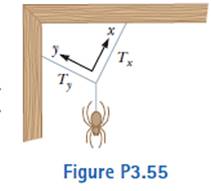
Concept explainers
In Figure P3.55, a spider is resting after starting to spin its web. The gravitational force on the spider makes it exert a downward force of 0.150 N on the junction of the three strands of silk. The junction is supported by different tension forces in the two strands above it so that the resultant force on the junction is zero. The two sloping strands are perpendicular, and we have chosen the x and y directions to be along them. The tension Tx is 0.127 N. Find (a) the tension Ty, (b) the angle the x axis makes with the horizontal, and (c) the angle the y axis makes with the horizontal.

Trending nowThis is a popular solution!

Chapter 3 Solutions
EBK PHYSICS FOR SCIENTISTS AND ENGINEER
Additional Science Textbook Solutions
Biology: Concepts and Investigations
Chemistry: Structure and Properties (2nd Edition)
Chemistry: The Central Science (14th Edition)
EBK INTRODUCTION TO CHEMISTRY
Cosmic Perspective Fundamentals
- Thank you.arrow_forward6. Is the true pendulum an example of SHM? Explain.arrow_forwardIn the circuit shown below & = 66.0 V, R5 = 4.00, R3 = 2.00, R₂ = 2.20 ₪, I5 = 11.41 A, I₁ = 10.17 A, and i̟ = 6.88 A. Find the current through R2 and R3, and the values of the resistors R₁ and R. (Due to the nature of this problem, do not use rounded intermediate values-including answers submitted in WebAssign-in your calculations.) 12 = 8.12 8.12 13 R₁₁ = RA = A Based on the known variables, which two junctions should you consider to find the current I3? A 6.9965 61.5123 Ω Which loop will give you an equation with just R4 as the unknown? Did you follow the sign convention for the potential difference across each element in the loop? R₁ www 11 R₂ www R4 www 14 8 15 www R5 www R3arrow_forward
- A car traveling at 42 km/h hits a bridge abutment. A passenger in the car moves forward a distance of 53 cm (with respect to the road) while being brought to rest by an inflated air bag. What magnitude of force (assumed constant) acts on the passenger's upper torso, which has a mass of 43 kg? Number i Unitsarrow_forwardThree resistors R₁ = 88.1 Q, R2 = 19.9 £2, R3 = 70.00, and two batteries & ₁ = 40.0 V, and ε2 = 353 V are connected as shown in the diagram below. R₁ www E₁ E2 R₂ ww ww R3 (a) What current flows through R₁, R2, and R3? 11 = 0.454 Did you choose directions for each of the three currents? Given that you have three unknowns to solve for, how many equations, at the least, will you need? A 12 = 1.759 Did you choose directions for each of the three currents? Given that you have three unknowns to solve for, how many equations, at the least, will you need? A 13 2.213 = Did you choose directions for each of the three currents? Given that you have three unknowns to solve for, how many equations, at the least, will you need? A (b) What is the absolute value of the potential difference across R1, R2, and R3? |AVR1 = 40.0 How is the potential difference related to the current and the resistance? V |AVR2 = 35.0 How is the potential difference related to the current and the resistance? V |AVR3 =…arrow_forwardIn the attached image is the circuit for what the net resistance of the circuit connected to the battery? Each resistance in the circuit is equal to 14.00 kΩ. Thanks.arrow_forward
- Determine the equivalent capacitance for the group of capacitors in the drawing. Assume that all capacitors be the same where C = 24.0 µF. Thank you.arrow_forwardIn the figure below, what is the net resistance of the circuit connected to the battery? Assume that all resistances in the circuit is equal to 14.00 kΩ. Thank you.arrow_forwardDue to the nature of this problem, do not use rounded intermediate values-including answers submitted in WebAssign-in your calculations. 3 4 Find the currents flowing in the circuit in the figure below. (Assume the resistances are R₁ =6, R₂ = 20, R₂ = 10 N, R₁ = 8, r₁ = 0.75 0, r2=0.50, 3 × A × A I, = 3.78 12 13 = 2.28 = 1.5 × A R₁ b a R₁₂ w C 1, 12 13 R₂ E3 12 V E₁ 18 V g Ez 3.0 V 12 Ea شرة R₁ e 24 V d = 0.25 0, and 4 = 0.5 0.)arrow_forward
 Principles of Physics: A Calculus-Based TextPhysicsISBN:9781133104261Author:Raymond A. Serway, John W. JewettPublisher:Cengage Learning
Principles of Physics: A Calculus-Based TextPhysicsISBN:9781133104261Author:Raymond A. Serway, John W. JewettPublisher:Cengage Learning Physics for Scientists and Engineers: Foundations...PhysicsISBN:9781133939146Author:Katz, Debora M.Publisher:Cengage Learning
Physics for Scientists and Engineers: Foundations...PhysicsISBN:9781133939146Author:Katz, Debora M.Publisher:Cengage Learning Physics for Scientists and Engineers, Technology ...PhysicsISBN:9781305116399Author:Raymond A. Serway, John W. JewettPublisher:Cengage Learning
Physics for Scientists and Engineers, Technology ...PhysicsISBN:9781305116399Author:Raymond A. Serway, John W. JewettPublisher:Cengage Learning Physics for Scientists and Engineers with Modern ...PhysicsISBN:9781337553292Author:Raymond A. Serway, John W. JewettPublisher:Cengage Learning
Physics for Scientists and Engineers with Modern ...PhysicsISBN:9781337553292Author:Raymond A. Serway, John W. JewettPublisher:Cengage Learning Physics for Scientists and EngineersPhysicsISBN:9781337553278Author:Raymond A. Serway, John W. JewettPublisher:Cengage Learning
Physics for Scientists and EngineersPhysicsISBN:9781337553278Author:Raymond A. Serway, John W. JewettPublisher:Cengage Learning Glencoe Physics: Principles and Problems, Student...PhysicsISBN:9780078807213Author:Paul W. ZitzewitzPublisher:Glencoe/McGraw-Hill
Glencoe Physics: Principles and Problems, Student...PhysicsISBN:9780078807213Author:Paul W. ZitzewitzPublisher:Glencoe/McGraw-Hill





